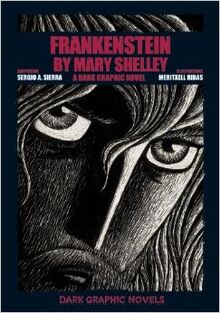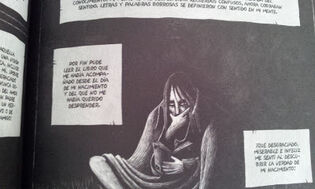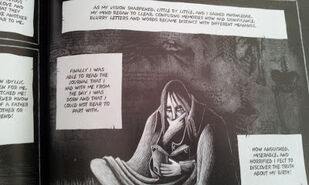
Front cover of Frankenstein by Mary Shelley: a Dark Graphic Novel (2012) Digital Image. amazon.com. N.p., 12 Aug. 2013. Web. 15 Apr. 2015.
Sergio A. Sierra's Frankenstein by Mary Shelley: a Graphic Novel is one of the graphic novel adaptations that the Enslow Publishing Company published in the Dark Graphic Novels series. Frankenstein by Mary Shelly: a Dark Graphic Novelwas originally a 2009 text written in Spanish, but was translated and sold in 2012 in English.
Synopsis[]
Just like in Mary Shelley's novel, this graphic novel follows the events of Victor's life as it was told: the perfect domestic home where he is raised, the creation of the creature, and the destruction of Victor and everything he holds dear. This graphic novel even keeps the same frame narrative with Walton relaying his trip to his sister, Victor Frankenstein telling his tale to Walton, and the creature telling his tale to Victor. Each shift in the story teller also shifts the first person point of view in which the story is told.
The Illustrations, done by Meritxell Ribas, are done in black and white scratchboard. This form of illustrating is time consuming, but gives the illustrations a darker atmosphere in even the happiest scenes, emphasizing the story's gothic nature and origins. The layout of Frankenstein is standard for a graphic novel, but there is a heavy reliance on narration. While there are panels of silence, they are simply used to show the monster's constant physical presence as well as presence in Victor's mind. (Sierra, 37,66)
The text itself occasionally employs direct speech to summarize larger passages of Shelley's narration, but narration boxes are the general method of story telling. There are three fonts: one that is more curved and elegant used in narration bubbles, a more linear capital letter font used for speech that is bolded when needed to express emotion, and a third a less refined, blotchy-looking capital letter font used for the creature's speech. Though the boxes for the narration and speech are not made up of perfectly straight lines, the boxes of the creature's dialogue and narration have extra little nicks and cuts, emphasizing the creature having an unskilled mastery over his language facilities.
Major Themes[]
Life and Death[]
Perhaps the most explicit theme is the relationship between life and death and with that, creation. The graphic novel is prefaced with a quote from J. Milton's Paradise Lost that is a pleading question: "Did I request thee, Maker, from my clay to mould me man?" (Sierra, 4) Victor's interest, or perhaps obsession, of life and death stems from the death of his mother. The young Victor who was faced with the loss of his mother, is depicted sitting next to a tombstone with the personification of death looking over his shoulder, swearing "that in the future, (he) would study the mysteries of life and death." (Sierra, 15)
Even before the death of Victor's mother, there was heavy hinting at creation with electricity as Victor notes the disintegrated tree, wondering how this power could be harnessed for man's use. (Sierra, 14) Victor spends much time vigilantly studying the sciences, visiting charnel houses, and performing horrific experiments on animals. The creation scene itself is a full page of Victor yelling "it's alive!" over the creature's body as it is engulfed in electricity. (Sierra, 24)
Probably the most interesting use of Death in this adaptation is the quantifying of Death as the exacting of a price. When the creature rages at the injustice done to him by the DeLacy family, his initial reaction is that the only compensation he can obtain is through murders that will inflict pain on Victor. (Sierra, 39) Later, when Victor refuses to make the creature a female companion, he swears vengeance and kills both Henry and Elizabeth. Victor also takes part in the transaction, making his exacting price the death of the monster as punishment for all of the murders the monster committed. (Sierra, 83) The irony of that idea is that after Victor's death, the creature knows that being the only one left alive is far worse a punishment than death. (Sierra, 93)
Nature versus Nurture[]
Much like Mary Shelley's original work, Frankenstein by Mary Shelley: a Dark Graphic Novel also lends itself to the Nature versus Nurture debate. The graphic novel takes a Lockean "blank slate" point of view as the creature learns about himself and the world through interactions with people in cities and villages, as well as through interactions with nature (Sierra, 49, 50, 51). While the creature's appearance frightens humanity, the creature's innocent nature is emphasized by interacting with nature and being accepted by small woodland creatures. (Sierra, 50)
The creature's breaking point is reached when he is shunned by the DeLacy family. Unable to deal with the despair he has felt interacting with humanity, the creature deals with his emotions by burning down the DeLacy house in revenge. (Sierra, 58) Though this is the point where the creature declares he has turned his back on humanity, he appears to not give up on humanity so easily. The monster sees William as a possible companion if the young boy has not been educated in the ways of prejudice, but that proves fruitless. (Sierra, 59)
Even when the creature demands that Victor make him a female companion to share the rest of his life with, he never threatens Victor with violence, but calls Victor to fulfill his responsibilities and duties as a creator to bring happiness to his creation. (Sierra, 46, 60) Only when Victor breaks his promise does the monster dissolve into killing Henry and Elizabeth.
In the end, the idea that the creature is monster-minded, prone to killing and violence, is ultimately overthrown. The creature expresses this to Walton and claims he did not enjoy the violence he inflicted, but rather, the creature felt like there was no other choice. (Sierra, 92) When Walton tells the monster his actions were wrong, the creature does not argue the right and wrong of the situation, only that "it is easy to judge without having suffered. (It is) a convenient morality." (Sierra, 94) The monster sees the value of life and finds no pleasure in killing, but the creature has never been given an avenue to turn towards. That being said, after Victor's death, the monster awaits the end, seeing death as the final resolution.
Reception[]
Both Frankenstein by Mary Shelley: a Dark Graphic Novel and the other Dark Graphic Novels have not received any distinguished awards, but they fulfill many Common Core Language Standards, Reading standards, as well as Writing Standards for grades 5 and above. (Directly from Enslow Publishing's website) Frankenstein by Mary Shelly: a Dark Graphic Novel has been deemed useful for education and popular enough to receive translations from its original language to Castilian, French, English, and Brazilian.
Significance of Adaptation[]

Frankenstein original Spanish edition (2009) page 48. Picture taken by Sergio Sierra. frankensteincom.blogspot.com. N.p., 19 Mar. 2013. Web. 15 Apr. 2015.

Frankenstein by Mary Shelley: a Dark Graphic Novel (2012) page 53. Picture taken by Sergio Sierra. frankensteincom.blogspot.com. N.p., 19 Mar. 2013. Web. 15 Apr. 2015.
Like Classics Illustrated Deluxe's Frankestein, as well as the rest of the Dark Graphic Novel Series, Frankenstein by Mary Shelley: a Dark Graphic Novel became another addition to the graphic novel adaptations of classical literature. The point of these graphic novels is to become a venue for a grade school level audience to begin to delve into classic literature. Many magazines and journals, such as The Horn Book Guide, TriState Young Adult Book Review Committee, Library Media Connection, and Booklist praise Frankenstein by Mary Shelley: a Dark Graphic Novel for not only being a book "that will relate well to many young readers," but also presenting Mary Shelley's work illustrated in a way that is "durable" and "chilling". The book still stays true to the horror genre, but with an accessible "PG rating" to ensure that it is suitable for a younger audience.
This adaptation is also important in terms of transition from a Spanish publication to an English one. While English text is at an advantage due to Frankenstein; or The Modern Prometheus being originally written in English, this is not the transition Sergio A. Sierra finds important. In his blog, Sierra talks about the quality work Meritxell Ribas puts into her scratchboard illustrations that the publishing company ignored by "subtract(ing) detail" in the Spanish and French editions. This detail was restored in Enslow's English version in its entirety, pleasing both the author and illustrator. Noted by the pictures on the right, there is a stark difference in backgrounds between the original version and the English version. It is also worth noting that the original fonts used in the Spanish version are kept in the English version. Sergio Sierra also talks about some issues with rights to sale that Enslow worked with Parramon Ediciones (the original publishing company) to smooth out. The overall professionalism between the two companies lends to international relations on a business level and a literary level.
References[]
"Enslow Publishing | Pre-K-12 Nonfiction, Ficton, and Graphic Novel Books!" Enslow Publishing | Pre-K-12 Nonfiction, Ficton, and Graphic Novel Books! Web. 18 Apr. 2015. <http://www.enslow.com/>.
"Enslow Dark Graphic Novels" Enslow Publishing | Pre-K-12 Nonfiction, Ficton, and Graphic Novel Books! Web. 18 Apr. 2015. <http://enslow.com/series/dark_graphic_novels/335#.VTKtK9VViko>
"Frankenstein By Mary Shelley" Enslow Publishing | Pre-K-12 Nonfiction, Ficton, and Graphic Novel Books! Web. 18 Apr. 2015. <http://enslow.com/books/frankenstein_by_mary_shelley/952#.VTGuKdVVgoK>
Sierra, Sergio A. "FRANKENSTEIN Made in USA." FRANKENSTEIN. Web. 18 Apr. 2015. <http://frankensteincom.blogspot.com/>
Sierra, Sergio A., and Meritxell Ribas. Frankenstein by Mary Shelley: A Dark Graphic Novel. English ed. Berkeley Heights, NJ: Enslow, 2013. Print.
